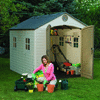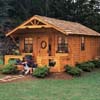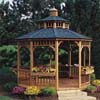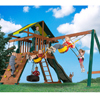| Arrow Sheds | |
 |
Low Price Guarantee |
 |
Free Shipping |
 |
No Sales Tax except ca |
| Sheds |
Garden ShedsGarden Sheds are perfect for any items that could easily be stored in the garage or utility area. However, a garden shed is so much more than just an every day storage area, as it can have a character all of its own. It can serve many purposes other than the obvious practical ones. It's a great place for potting plants or perhaps a hobby room for the messy projects you may not want in the house.
The first thing you have to do before adding a shed is to obviously decide its location. The location of the shed will help determine the size and style of the shed. You need to consider many different things such as ease of access, how the shed will look in the chosen area, security, practicality and so on. When the location has been decided and the size of the shed determined then the next thing to so is lay the base. You can use a layer of gravel or build a concrete base. Whatever the base though, it should be level. Do not contemplate adding a shed straight onto the grass. While this may seem obvious people will do it ! It is important that the wooden shed should not be contact with the ground to avoid the wood rotting. Another alternative is to lay the shed on timbers. The type of shed is the important decision. The choices are simple metal, plastic, vinyl or wooden sheds. Whatever the structure in your garden these are the three basic materials used and the characteristics remain the same for each. Wood provides the classical look, plastic is cheaper, vinyl is maintenance free and metal is stronger. It really is just your preference and what coordinates best with your house and landscape. Another important decision is whether to build the shed yourself or get a professional to do it. Although shed kits usually give you a substantial discount, they require much more time and energy but are usually very easy to do, great for a weekend project. Having said that the decision is relatively easy if your honest with yourself about your DIY capabilities. Once, the shed is in place you need to give the wood some protection. While the materials will come with a guarantee, you should still regularly add a protective coating. If you are putting together a kit, a good tip is to paint as much of the shed as possible before assembly, since it is much easier to paint some parts of the shed before assembly, rather than standing on a ladder to do it. Unless you are getting a particularly large or unusual shed, it is unlikely you will need planning permission, but always check. You don't want to be moving a full sized shed several feet, so you want to be sure you have it in the right place to begin with. |
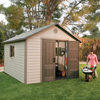 A garden shed can be used as a place to plan
and plot your garden's development or just as a place of
sanctuary and contemplation. A garden shed can also be
used to add depth and character to a garden or even as the
focal point with the garden designed to complement the
shed. For the uninitiated a garden shed is just another
shed. However, there are many different styles, which can
add their own individual charm and character to your
garden.
A garden shed can be used as a place to plan
and plot your garden's development or just as a place of
sanctuary and contemplation. A garden shed can also be
used to add depth and character to a garden or even as the
focal point with the garden designed to complement the
shed. For the uninitiated a garden shed is just another
shed. However, there are many different styles, which can
add their own individual charm and character to your
garden.